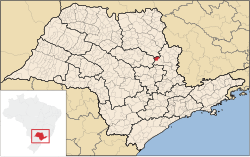Porto Ferreira
| Porto Ferreira | |
|---|---|
| Municipality | |
 Location in São Paulo state |
|
| Location in Brazil | |
| Coordinates: 21°51′14″S 47°28′44″W / 21.85389°S 47.47889°WCoordinates: 21°51′14″S 47°28′44″W / 21.85389°S 47.47889°W | |
| Country |
|
| Region | Southeast Region |
| State | São Paulo |
| Mesoregion | Campinas |
| Microregion | Pirassununga |
| Government | |
| • Mayor | Renata Anchão Braga (PSDB) |
| Area | |
| • Total | 244.9 km2 (94.6 sq mi) |
| Elevation | 559 m (1,834 ft) |
| Population (2015) | |
| • Total | 54,761 |
| • Density | 220/km2 (580/sq mi) |
| Time zone | BRT/BRST (UTC-3/-2) |
Porto Ferreira is a municipality in the state of São Paulo in Brazil. It is situated on the Mojiguaçu River at an altitude of 559 meters. The population is 54,761 (2015 est.) in an area of 244.9 km².
The valley where Porto Ferreira now lies used to be inhabited by Payaguá people. The settlement Porto Ferreira on the Mojiguaçu River was founded in the 1860s, at the place of a ferry. It was named Ferreira after the ferryman João Inácio Ferreira. The settlement grew because of its strategic location on the way to the coffee plantations in the region of Ribeirão Preto. Porto Ferreira was officially established on 9 February 1888, as a part of the municipality Descalvado. It was detached from Descalvado and attached to Pirassununga on 1 October 1892. It became an independent municipality on 29 July 1896.
Data of the Census - 2010 Total population: 58.797
Per capita income: U$$3879,56 (estimative of 2010) Urbanization rate: 96.61% Annual Population Growth rate: 1.86% Number of hospital beds: 45 (per thousand inhabitants - 0,73)
Population that has access:
Source: IBGE
The highest point of the city is the High Mount, with 798 meters. The lowest point is the Island of the Ducks, with 545 meters. In the Railroad station the altitude is of 549.7 meters above sea level.
The municipality holds the 611 hectares (1,510 acres) Porto Ferreira State Park, created in 1987.
annual average
The City is plain, with small undulations, slightly inclined for the basins of the Moji Guaçu and its tributaries. To the north, mountainous.
Rodovia Anhangüera (SP 230), SP 215 and FEPASA, currently disactivated, with some stretches with the removed tracks.
Four types of soil are found, thus distributed for the area of the city: Yellow Red Latosol (62 km ²), Purple Latosol (74 km ²), Hidromórfico (27 km ²) and Dark Red Latosol (77 km ²).
...
Wikipedia

